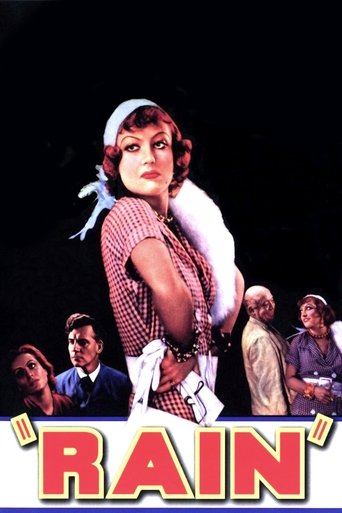A woman without shame. A woman without soul.
"Rain" (1932), a cinematic gem produced by Feature Productions in the United States, is a compelling adaptation of W. Somerset Maugham's short story "Miss Thompson." Directed by Lewis Milestone, the film stars Joan Crawford in a riveting performance as Sadie Thompson, a provocative and free-spirited woman stranded on a South Pacific island during a relentless downpour. The film's atmospheric setting, drenched in rain and moral tension, serves as a backdrop to the intense character dynamics and the clash between Sadie and the puritanical Reverend Alfred Davidson, portrayed by Walter Huston. The narrative delves deep into themes of morality, redemption, and human nature, making "Rain" a timeless exploration of societal norms and personal transformation. The film's visual and thematic elements are masterfully intertwined, with the incessant rain symbolizing the inescapable confrontation with one's inner demons. Cinematographer Oliver T. Marsh captures the moody, oppressive atmosphere of the island, enhancing the film's dramatic tension. The rain-soaked streets and the claustrophobic interiors of the boarding house where Sadie and the other characters are confined amplify the sense of entrapment and the brewing storm of emotions. This visual storytelling complements the film's narrative, creating a palpable sense of urgency and inevitability as the characters grapple with their moral dilemmas. Joan Crawford's portrayal of Sadie Thompson is a tour de force, showcasing her versatility and depth as an actress. Sadie's journey from a carefree, rebellious woman to one seeking redemption is portrayed with nuance and intensity, making her one of Crawford's most memorable roles. The chemistry between Crawford and Walter Huston, who delivers a powerful performance as the conflicted Reverend Davidson, adds layers to the film's exploration of morality and hypocrisy. Their confrontations are charged with emotional and psychological intensity, driving the film's narrative to its dramatic climax. "Rain" (1932) remains a significant work in American cinema, not only for its bold thematic content but also for its technical achievements. The film's use of sound, particularly the omnipresent sound of rain, and its innovative cinematography set it apart from its contemporaries. As a product of Feature Productions, "Rain" exemplifies the studio's commitment to pushing the boundaries of storytelling and visual artistry. Its enduring relevance lies in its unflinching examination of human nature and the societal constructs that shape our moral compass, making it a must-watch for cinephiles and scholars alike.
Año1932
Duración94 minuto
GénerosDrama
Países de producciónUnited States of America
